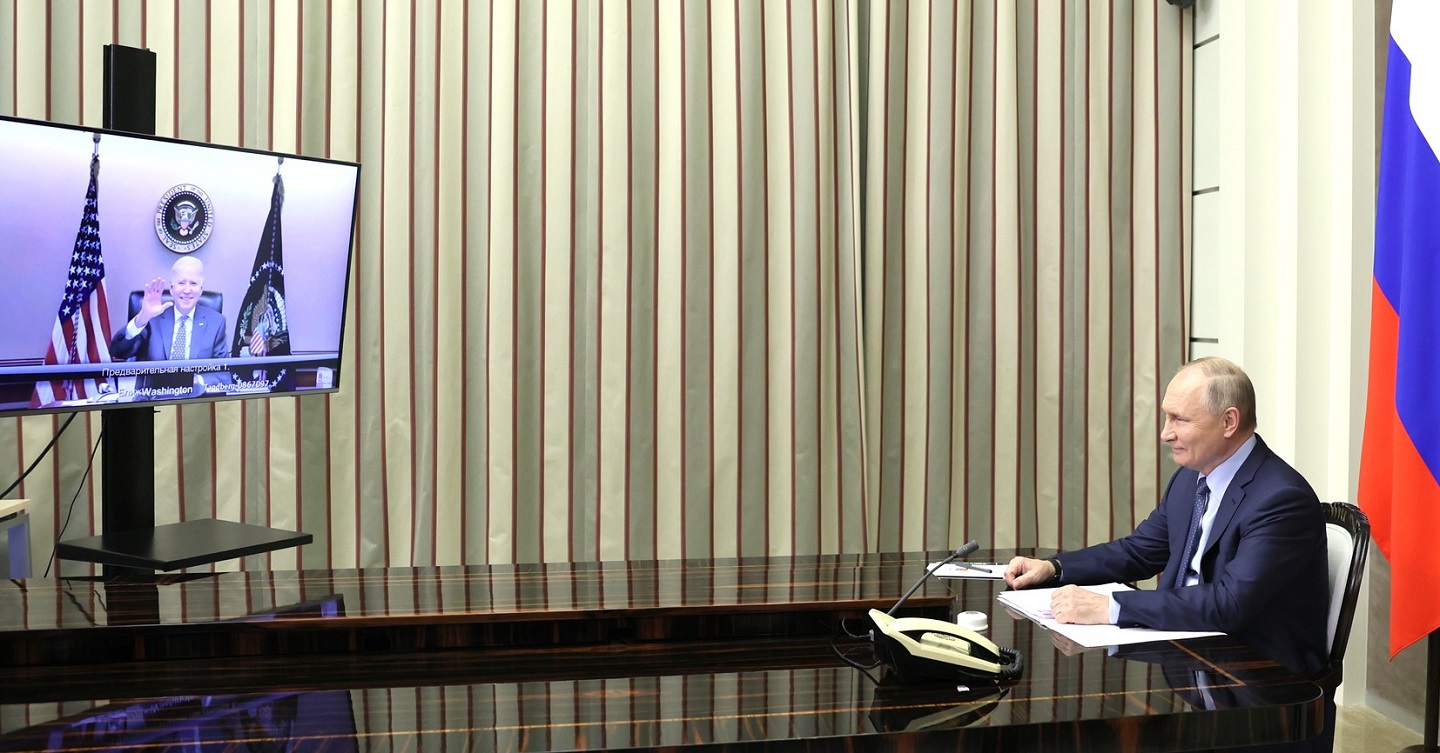
[O]ur lesson on NATO expansion indicates that Russia was deeply disturbed by the eastward encroachment of NATO into territory Russia once controlled as the Soviet Union during the Cold War.
Like most of War Room’s readers, few of our Army War College students are experts on Russia or Ukraine, yet our course of study equips them to draw meaningful conclusions about the likely spectrum of what Russia is trying to achieve by massing troops on Ukraine’s borders and ostensibly threatening invasion. In particular, lessons on coercion and case studies regarding NATO expansion and the 1995-96 Taiwan Straits crisis, sprinkled with a little knowledge about the credibility of threats, suggest that Russia envisions more than one acceptable outcome.
First, Ukraine’s current unenviable situation illustrates why so many eastern European countries sought NATO membership after the collapse of the Soviet Union. More importantly, our lesson on NATO expansion indicates that Russia was deeply disturbed by the eastward encroachment of NATO into territory Russia once controlled as the Soviet Union during the Cold War. Russia surely would have preferred a different outcome then and Russian officials still think that additional NATO expansion threatens Russia’s vital national interests. And, as we teach, vital interests are worth fighting over. But does Russia seek to prevent further NATO expansion primarily through coercive diplomacy by rattling its saber along Ukraine’s border? Or does Russia prefer to take matters into its own hands as it did with its war with Georgia, its seizure of Crimea in 2014, and its ongoing support for the separatists in eastern Ukraine? Our lessons on coercion and the Taiwan Straits crisis suggest some form of the latter while preserving options for the former.
During the Taiwan Straits crisis, China conducted threatening military exercises close to Taiwan after the United States granted a visa to a Taiwanese presidential candidate who favored promoting Taiwanese independence. China viewed this as an unfavorable shift in the delicate status quo. Accordingly, it used the threat of force to compel the Taiwanese to quiet their agitation for independence and compel the United States to promise to issue no more visas to Taiwanese officials. China somewhat succeeded with the first objective and mostly failed in the second. As we teach and China discovered in this case, compellence is generally more difficult than deterrence.
Approximately 25 years later, Russia’s massive military “exercises” on Ukraine’s borders have created a new crisis with important similarities and differences to the Taiwan Straits crisis. Like China versus the United States regarding Taiwan, Russia has a more direct and intense security interest and cultural connection to the fate of Ukraine than does the United States and NATO. U.S. and NATO interests are more abstract and related to maintaining international norms of the current “liberal world order” and thus may seem less intense and more difficult to communicate. Another similarity is that Russia’s demands appear to attempt to compel action from the United States by threatening brute force against a third party that the United States is willing to sacrifice, albeit reluctantly, because it is not a vital interest. This interest asymmetry creates two dynamics that make a diplomatic solution harder. On the one hand, NATO will be hard-pressed to deter Russia’s intense interest in improving its security situation by force, if necessary. On the other hand, Russia’s coercive threats against a less intense interest of the United States are unlikely to work, much like China failed to compel the United States to accede to its demands during the Taiwan Straits crisis. Russia’s overt demands are unrealistically high and not matched by a threat of sufficient direct cost to the United States or NATO.
This discrepancy between demands and means might explain why the United States is so pessimistic about Russian intentions; Russia’s current approach to coercion does not seem genuinely interested in “negotiation” because they are not threatening something the United States values enough. Nonetheless, Russia will take any “free chicken” they can get from crisis diplomacy with the United States, but they are not likely to get much. Talking for at least a limited time will not cost Russia much, could improve their image slightly, and help them refine their cost-benefit calculation before committing to other actions.
The third potential similarity that seems underreported in the U.S. press is the possibility that Russia might primarily be trying to extract positive outcomes from Ukraine itself, much like the favorable election results that China’s threat to Taiwan seemed to produce. For example, implementation of the Minsk agreement of 2015 may provide Russia with enough gains to justify de-escalation. Greater insight into if this is happening would be helpful to know and could significantly shape U.S. perception of Russia’s intentions. Furthermore, the credibility of Russia’s threat to Ukraine is significantly higher than was China’s threat to Taiwan back in 1996, so it is at least plausible that Russia anticipates the mere fear of attack might produce an acceptable outcome in Ukraine.
Russia has already gained a strategic success by risking military action against Crimea.
Russia’s greater credibility in terms of capability and resolve is an important difference from the Taiwan Crisis. Although China had a clear interest in countering pro-independence momentum, its capability and resolve at that time were questioned. In contrast, Russia’s capability to overwhelm Ukrainian forces throughout the rest of Ukraine seems clear. It also appears to possess sufficient resolve to accept the risk and cost of implementing the threat. Russia has already gained a strategic success by risking military action against Crimea. Although Russia’s ability to translate force into enduring political objectives outside of Crimea is far less clear, one should not discount their willingness to gamble on this vital interest. Furthermore, Russia’s tolerance of the sanctions from its previous actions against Ukraine might make one wonder how much additional pain NATO countries are able and willing to impose indefinitely, especially when Russia yields substantial counter coercion against Germany, Hungary, and others due to its control over much of their supply of gas. This situation, too, helps explain apparent U.S. pessimism.
One might think another important difference between the two crises would be the potential restraining factor of the fact that Ukraine is a sovereign country whereas in 1996 most countries had already acceded since 1971 that Taiwan was part of “one China.” However, given that Ukrainian sovereignty did not restrain Russia in 2014 and that President Putin has made the case for the historical unity of Russia and Ukraine, we should not count on Ukraine’s sovereignty exerting much restraining influence now, though it may prompt Russia to seek at least a fig leaf to cover any aggressive actions it takes.
Can we infer any likely Russian actions by comparing these two cases? Possibly, if we consider the relatively low risks to their credibility that both China and Russia put at stake by engaging in provocative military actions. First, their control of domestic media makes internal consequences of saber-rattling low. Second, one might think that bluffing invasion might have significant adverse consequences on Russia’s future credibility in the eyes of foreign powers, but, like China, Russia has not overtly threatened invasion. China made it very clear to the United States that it did not intend to invade Taiwan. Nonetheless, China’s actions imposed cost on the United States by requiring U.S. officials to divert their attention and agendas to address the provocation, and China was rewarded with an informal presidential summit.
Judging from the reaction of U.S. officials, Russia has not similarly given the United States such explicit assurances. Nonetheless, by publicly insisting it is just conducting exercises while allowing inferences to the contrary, Russia reduces the likelihood and magnitude of damage to the credibility of its future threats if it chooses not to invade this time. As long as it gets something of plausibly sufficient value from NATO or just the United States, Russia can claim that its huge military exercises were not a bluff but rather an appropriately “loud” way of communicating its intense dissatisfaction with the status quo. If, however, no meaningful concessions are forthcoming, Russia is likely willing to take at least some limited forcible action both to save face and improve its security in the light of NATO intransigence.
Thus, Russia’s apparent decision to preserve a diplomatic pathway that will allow it to save face without violence presents a narrow opportunity for the United States and its allies to work with Russia to de-escalate. Although NATO is rightfully reluctant to reward bad behavior too generously, its “principled and pragmatic” approach seems to accept Russia has some legitimate concerns for its security, which NATO may be able to address at least partially. NATO should also factor into its cost-benefit calculations that coercion theory suggests that it should take less threatened carrot and stick to deter Russia from military action than it will take to compel Russia to undo any military action after the fact.
It is unclear if the United States and its allies are willing to offer enough inducements and credible punishments to prevent Russia from taking aggressive actions. It would be unlikely for Putin to engage in this costly and somewhat risky escalation if he did not have at least two satisfactory though not equally preferred outcomes in mind. He surely prefers significant concessions, however unlikely they may be. But creating facts on the ground through a coup, expanding his grab of Ukrainian territory, or at least formalizing control over the Donbas may also be an acceptable outcome, even though more costly, riskier, and less preferred. Russia is indeed testing the United States. A narrow de-escalation window exists, but both sides must be willing to use it.
Leon Perkowski is a Colonel in the U.S. Air Force, an Assistant Professor in the Department of National Security and Strategy, and the Director of the Eisenhower Series College Program at the U.S. Army War College. He holds an MS in Environmental Pollution Control from Pennsylvania State University and a Ph.D. in the History of U.S. Foreign Relations from Kent State University.
The views expressed in this article are those of the author and do not necessarily reflect those of the U.S. Army War College, the U.S. Army, the U.S. Air Force, or the Department of Defense.
Photo Description: President of Russia Vladimir Putin meeting with U.S. President Joseph Biden (via videoconference).
Photo Credit: Presidential Executive Office of Russia and is licensed under the Creative Commons Attribution 4.0





Just as Vietnam’s lessons learned should have been relooked at in Afghanistan, perhaps the Polish Crisis in the early-1980’s should be today.
In both Poland, the USSR, now Russia, was positioned to the east with overwhelming forces in the Baltic and the Ukraine and behind in further depth.
Unlike today, NATO’s political climate was unified and mutually supporting, especially with the large number of US forces positioned in W. Germany and elsewhere. Today, each country has their own problems with energy and the military budgets – for some these are their prime concerns.
Since the end of the Warsaw Pact, big battles with large forces have been a thing of the past. Wars of every kind never fully go away.
First, let’s look at this from the beginning of our article above:
“Like most of War Room’s readers, few of our Army War College students are experts on Russia or Ukraine, yet our course of study equips them to draw meaningful conclusions about the likely spectrum of what Russia is trying to achieve by massing troops on Ukraine’s borders and ostensibly threatening invasion. … ”
Next, let’s consider the following from the War on the Rocks article “America Did Hybrid Warfare Too:”
“The purpose of all this? Defending America from hostile foreign interference — the Monroe Doctrine. But it was also a ‘forward strategy for freedom,’ as Secretary of State George Shultz called it, which above all served to demonstrate that America had revitalized its will to oppose the Soviet Union in the Cold War. …”
Question:
If, indeed, we are in a New/Reverse Cold War today, one in which the U.S./the West is seen by much of the world as the aggressor, and such nations as China and Russia seen as the defenders, then:
a. As relates to the question posed in my first quoted paragraph above, to wit: “what is Russia trying to achieve by massing troops on Ukraine’s borders and ostensibly threatening invasion?”
b. Might the answer to this question be as found in my second quoted paragraph above (properly modified for the New/Reverse Cold War), to wit: “defending RUSSIA from hostile foreign interference”/”demonstrating that RUSSIA had revitalized its will to oppose the U.S./the West in the New/Reverse Cold War?”
Final question, based on the matters I have presented above:
Are our War College students today not provided with an opportunity to view the post-Cold War world more from the perspective of a New/Reverse Cold War; one in which the U.S./the West is engaged in expansion (of our way of life, our way of governance, our values, etc.) and much of the Rest of the World (for example Russia, China, Iran, N. Korea, the Islamic World, etc.) — confronted with this such existential threat — is engaged in “containment” and “roll back?”
(If not, then how can they hope to understand why, during the Old Cold War of yesterday, the U.S./the West would seek to work “by, with and through” the more conservative elements of the world’s populations. And why, in the New/Reverse Cold War of today, it is our opponents who seek to work by, with and through these such more conservative elements today:
“Liberal democratic societies have, in the past few decades, undergone a series of revolutionary changes in their social and political life, which are not to the taste of all their citizens. For many of those, who might be called social conservatives, Russia has become a more agreeable society, at least in principle, than those they live in. Communist Westerners used to speak of the Soviet Union as the pioneer society of a brighter future for all. Now, the rightwing nationalists of Europe and North America admire Russia and its leader for cleaving to the past.”
[See “The American Interest” article “The Reality of Russian Soft Power” by John Lloyd and Daria Litinova.])
Here is some additional information, that may support my thoughts above; this, as relates to my suggestion of a New/Reverse Cold War — one in which the U.S./the West is seen as the “revolutionary” expansionist aggressors. (And one in which, accordingly, our opponents [both state and non-state] are seen, in the face of this existential threat, as being the “resistance” forces, employing “containment” and/or “roll back” measures):
a. From then (1993) National Security Advisor Anthony Lake’s “From Containment to Enlargement” — the precursor/the introduction to then-President Bill Clinton’s “Engagement and Enlargement” strategic document:
“Throughout the Cold War, we contained a global threat to market democracies; now we should seek to enlarge their reach, particularly in places of special significance to us. The successor to a doctrine of containment must be a strategy of enlargement — enlargement of the world’s free community of market democracies. During the Cold War, even children understood America’s security mission; as they looked at those maps on their schoolroom walls, they knew we were trying to contain the creeping expansion of that big, red blob. Today, at great risk of oversimplification, we might visualize our security mission as promoting the enlargement of the ‘blue areas’ of market democracies. The difference, of course, is that we do not seek to expand the reach of our institutions by force, subversion or repression.” (As we all know, however, after 9/11, “force,” etc., would indeed be utilized.)
b. From Jennifer Lind and Daryl G. Press’ Foreign Affairs (the Mar/Apr 2020 issue) article entitled “Reality Check: American Power in an Age of Constraints:”
“For the past three decades, as the United States stood at the pinnacle of global power, U.S. leaders framed their foreign policy around a single question: What should the United States seek to achieve in the world? Buoyed by their victory in the Cold War and freed of powerful adversaries abroad, successive U.S. administrations forged an ambitious agenda: spreading liberalism and Western influence around the world, integrating China into the global economy, and transforming the politics of the Middle East. … This approach to foreign policy was misguided even at the peak of American power. As the endless wars in Afghanistan and Iraq and Russian interventionism in eastern Europe have shown, adversaries with a fraction of the United States’ resources could find ways to resist U.S. efforts and impose high costs in the process.”
c. From the 2013 Small Wars Journal article “Learning From Today’s Crisis of Counterinsurgency” by Octavian Manea, an interview with Dr. David H. Ucko and Dr. Robert Egnell:
“Robert Egnell: Analysts like to talk about ‘indirect approaches’ or ‘limited interventions’, but the question is ‘approaches to what?’ What are we trying to achieve? What is our understanding of the end-state? In a recent article published in Joint Forces Quarterly, I sought to challenge the contemporary understanding of counterinsurgency by arguing that the term itself may lead us to faulty assumptions about nature of the problem, what it is we are trying to do, and how best to achieve it. When we label something a counterinsurgency campaign, it introduces certain assumptions from the past and from the contemporary era about the nature of the conflict. One problem is that counterinsurgency is by its nature conservative, or status-quo oriented – it is about preserving existing political systems, law and order. And that is not what we have been doing in Iraq and Afghanistan. Instead, we have been the revolutionary actors, the ones instigating revolutionary societal changes. Can we still call it counterinsurgency, when we are pushing for so much change?”
In the Old Cold War of yesterday, when it was the Soviets/the communists who were the “revolutionary” actors pressing, throughout the world back then, for significant political, economic, social and value change, it was the U.S./the West, back then — faced with this such existential threat — who (a) adopted “containment” and “roll back” strategies and, both at home and abroad, (b) courted and fully utilized the “natural enemy” of significant political, economic, social and value “change” (to wit: the conservative elements of the states and societies of the world).
In the New/Reverse Cold War of today, when it is the U.S./the West who is seen as the “revolutionary” actor now pressing, throughout the world, for significant political, economic, social and value change, now it is our enemies (exs: Russia, China, N. Korea, Iran, the Islamists, etc.) who — faced with this such existential threat — have (a) adopted “containment” and “roll back” strategies and, both at home and abroad, (b) courted and utilized the “natural enemy” of significant political, economic, social and value “change” (again: the conservative elements of the states and societies of the world):
“Compounding it all, Russia’s dictator has achieved all of this while creating sympathy in elements of the Right that mirrors the sympathy the Soviet Union achieved in elements of the Left. In other words, Putin is expanding Russian power and influence while mounting a cultural critique that resonates with some American audiences, casting himself as a defender of Christian civilization against Islam and the godless, decadent West.” (See the “National Review” item entitled: “How Russia Wins” by David French.)
Bottom Line Question — Based on the Above:
Given these facts, then can we actually say that (from the first paragraph of our article above) “the course of study our Army War College students get equips them to draw meaningful conclusions about the likely spectrum of what Russia is trying to achieve by massing troops on Ukraine’s borders and ostensibly threatening invasion.” This:
If this such course of study does not include significant discussion of the New/Reverse Cold War paradigm that I describe above?
Given my suggestion of a New/Reverse Cold War above — one in which (a) the U.S./the West, post-the Cold War, is doing expansion and Russia (and much of the Rest of the World), thus threatened, is doing “containment” and/or “roll back” — given my such suggestion, might we look at such things as “deterrence” and “coercion” from that such perspective? Example:
“The Declining Role of Deterrence:
During the Cold War, deterrence took pride of place in U.S. national security strategy, and for good reason. While some U.S. policymakers and analysts never gave up on the dream of circumventing “mutually assured destruction,” most understood that brute force was not an option when it came to the primary threats facing the country – thermonuclear war with a Soviet Union whose arsenal had reached rough parity with that of the United States and large-scale conventional war with a Warsaw Pact that overmatched NATO. This left coercion as the only broad option. Within the types of coercive strategies, compelling the Soviet Union to voluntarily make concessions was a non-starter, largely for the same reasons. The best the United States could hope to achieve was to deter Soviet attempts at further gains. Americans may never have embraced deterrence but most accepted that there simply weren’t any other real options.
However, since the Cold War, three changes have considerably reduced the role deterrence plays in U.S. strategy. First, the United States in many important respects no longer seeks to maintain the status quo, which means that even 100 percent successful deterrent efforts cannot achieve U.S. objectives. The collapse of the Soviet Union meant a loosening of constraints on the exercise of U.S. power, and U.S. goals have expanded accordingly. In each portion of the “four-plus-one” threat framework that the Department of Defense currently uses to guide planning and prioritization, the goal is to revise the relevant circumstances in America’s favor, not to maintain them. Specifically, U.S. leaders seek to slow, halt, or, ideally, roll back Chinese efforts in the South and East China Seas, Russian subversion of U.S. allies and partners in its perceived “near abroad,” Iranian pursuit of increased power and prestige in the Persian Gulf, North Korean progress on its nuclear weapons and related delivery vehicle programs, and violent extremist organizations’ increasing entrenchment across large swaths of the globe. Given these objectives, if the United States attempts to engage in coercive approaches, they are likely to involve compellence, or attempts to change the status quo, not deterrence.”
(See the December 7, 2017 War on the Rocks article “Deterrence in Retreat: How the Cold War’s Core Principle Fell Out of Fashion” by T. Negeen Pegahi.)
Bottom Line Question — Based on the Above:
The goal of the Soviet Union during the Old Cold War was expansionist in nature; that is, to expand the Soviets’ way of life, their way of governance, their values, etc., both at home and abroad; this, while the goal of the U.S./the West (and much of the Rest of the World), during the Old Cold War, was, via “containment,” to prevent this from happening. (And, under President Reagan, to “roll back” certain of these already accomplished Soviet/communist such gains?).
As the information presented in the War on the Rocks article above appears to indicate, a very different (and, from my perspective, a “reversed”) dynamic presents itself in post-Cold War of today.
Given on my such thoughts — and based on certain confirming (?) matters presented in our article War on the Rocks article above — might we consider that — re: this such “change” (which I call the New/Reverse Cold War):
a. The coercion and deterrence options (and constraints) of the U.S./the West during the Old Cold War; these are now what are available (or not) for use by our opponents, for example, Russia, today? And, accordingly:
b. The coercion and deterrence options (and constraints) of the USSR during the Old Cold War; these are now what are available (or not) for use by the U.S./the West today?
As relates to the New/Reverse Cold War suggestion that I provide above — and specifically as relates to the effort I address, therein, of Russia to attempt to work more “by, with and through” the more conservative elements of the world’s populations today — this, so as to “contain,” and/or to “roll back,” U.S./Western power, influence and control throughout the world,
As to these such matters, consider this current item, allegedly from our Permanent Representative of the U.S. and Other International Organizations in Geneva, Switzerland, Ambassador Bathsheba Nell Crocker:
“In a warning, Bathsheba Nell Crocker said the US has ‘credible information that indicates Russian forces are creating lists of identified Ukrainians to be killed or sent to camps following a military occupation’.
In a letter to the UN’s human rights chief she said ‘in the past Russian operations have included targeted killings, kidnappings/forced disappearances, unjust detentions, and the use of torture’.
Should Russia invade, she says forces ‘would likely target those who oppose Russian actions’.
These would include ‘Russian and Belarusian dissidents in exile in Ukraine, journalists and anti-corruption activists, and vulnerable populations such as religious and ethnic minorities and LGBTQI+ persons’. ”
(See today’s “Great Britain News” [gbnews.uk] article “Putin Drawing Up ‘Kill List’ of Gay and Ethnic Minority Ukrainians Ahead of Possible Invasion, US claims,” by Ben Chapman.)
Question:
Given the matters that I present above, how might we say that (a) the appeal to tolerance and diversity by the U.S./the West in the New/Reverse Cold War of today and (b) the appeal to conservatism by such entities as Russia today — how might these such matters effect (if at at all):
a. The willingness of the U.S./the West to “offer enough inducements and credible punishments to prevent Russia from taking aggressive actions.” (See the final paragraph of our War Room article above.) And/or effect:
b. The willingness of Russia to favorably (from the U.S./the West’s point of view at least) respond to these such inducements and credible punishments?
(As to Russia’s appeal to conservatism today, consider the following:
“In his annual appeal to the Federal Assembly in December 2013, Putin formulated this ‘independent path’ ideology by contrasting Russia’s ‘traditional values’ with the liberal values of the West. He said: ‘We know that there are more and more people in the world who support our position on defending traditional values that have made up the spiritual and moral foundation of civilization in every nation for thousands of years: the values of traditional families, real human life, including religious life, not just material existence but also spirituality, the values of humanism and global diversity.’ He proclaimed that Russia would defend and advance these traditional values in order to ‘prevent movement backward and downward, into chaotic darkness and a return to a primitive state.’
[See the Wilson Center publication “Kennan Cable No. 53” and, therein, see the article “Russia’s Traditional Values and Domestic Violence,” by Olimpiada Usanova, dated 1 June 2020.])
Strategic flooding!!!
Blow or block dams.
Drain or overflow reservoirs.
Check historic floods of Ukraine and Crimea
I accept that it should be the strategy of the US to help free people groups who are opposing endeavored enslavement by outfitted minorities or by outside pressures. I accept that we should help free people groups to figure out their own predeterminations in their own particular manner. I accept that our assistance ought to be principally through monetary and monetary guide which is vital for financial security and precise political cycles.
The Ukrainian military and political leadership have been able to fight the Russians and inflict devastating & catastrophic strategic losses on the Russian military. The capture of Kherson has been the biggest setback for Putin and the Russian Army, this was the first greatest strategic loss. The battle of Bakhmut is the second great loss for the Russians and it does not matter now if the Wagner terrorists can take over the remainder of the city, the Ukrainians have strategically won this battle too.
Within next weeks once the muddy ground gets dry and becomes more solid, the Ukrainians will be able to wage a massive counterattack involving and utilizing the newly delivered western tanks Challenger and Leopard 2 tanks and Bradley, Stryker, AMX-10 and Marder infantry fighting vehicles. These battle tanks and vehicles have much more superior firepower and high tech options vs. the Russian equipment. If Ukraine will have enough number of the tanks and fighting vehicles, they should be able to start a massive counterattack and liberate more of its occupied territories across Donbass, Luhansk and at a later stages Crimea.
The only strategy for the wanted war criminal Putin now is to keep inflicting massive civilian terror, casualties on the Ukrainians and keep attacking the civilian infrastructure to starve them and leave the Ukrainians without electricity or water supply. It feels like Putin is utilizing the usual Russian military playbook he used in Georgia, Chechnya, Crimea and Syria: win the war by spilling more civilian blood, inflict more civilian terror and keep committing more war crimes to further inflict more fear and terror.
Hopefully the NATO members, the US especially will be able to throw in more weaponry, especially the F-16 fighter jets, hopefully higher range MGM-140 ATACMS rockets, counter rocket C-RAM weapons systems to better fight the Iranian drones and more for air defenses to counter the Iranian drones and ballistic missiles.
With such phase this war will most likely end in 2023 or maximum with Crimea’s liberation within few months of the start of 2024. The Russian forces will be also forced to leave Moldova, Georgian regions of Abkhazia and Samachablo (so called South Ossetia), Nagorno-Karabakh and Syria. Ukraine will be victorious and the Russians should be very concerned about the fate that awaits afterwards. With the Ukrainian victory the world will forever destroy Russia’s imperialistic ambitions, Russian nationalism and this will save future generations from future wars and peace will definitely follow.